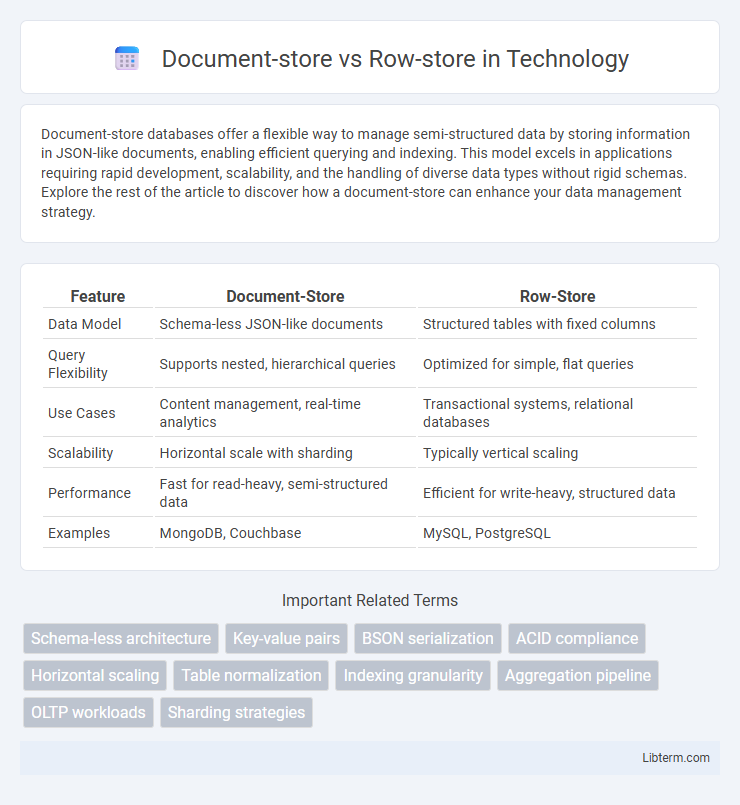Document-store databases offer a flexible way to manage semi-structured data by storing information in JSON-like documents, enabling efficient querying and indexing. This model excels in applications requiring rapid development, scalability, and the handling of diverse data types without rigid schemas. Explore the rest of the article to discover how a document-store can enhance your data management strategy.
Table of Comparison
| Feature | Document-Store | Row-Store |
|---|---|---|
| Data Model | Schema-less JSON-like documents | Structured tables with fixed columns |
| Query Flexibility | Supports nested, hierarchical queries | Optimized for simple, flat queries |
| Use Cases | Content management, real-time analytics | Transactional systems, relational databases |
| Scalability | Horizontal scale with sharding | Typically vertical scaling |
| Performance | Fast for read-heavy, semi-structured data | Efficient for write-heavy, structured data |
| Examples | MongoDB, Couchbase | MySQL, PostgreSQL |
Introduction to Data Storage Models
Document-store databases organize data as flexible, semi-structured documents, typically in JSON or BSON formats, allowing for nested fields and dynamic schemas. Row-store databases store data in fixed rows, optimizing for transaction processing and traditional relational queries with structured schemas. Document-stores excel in handling hierarchical data and rapid iteration, while row-stores offer robust ACID compliance and predictable performance in structured environments.
What is a Document-Store Database?
A document-store database is a type of NoSQL database designed to store, retrieve, and manage semi-structured data as documents, typically in JSON, BSON, or XML format. Unlike row-store databases that organize data in rows and columns within fixed schemas, document-stores allow for flexible, schema-less data models, enabling efficient handling of nested and hierarchical information. This structure supports rapid querying and updating of individual documents, making document-stores ideal for applications requiring agile data evolution and complex data representations.
What is a Row-Store Database?
A row-store database organizes data in rows, storing all columns of a record together, which optimizes performance for transactional workloads with frequent reads and writes of entire records. This approach contrasts with column-store databases, which store data by columns and excel in analytical queries involving aggregations on specific attributes. Row-store databases are commonly used in applications requiring fast insert, update, and delete operations, such as OLTP systems.
Core Data Structures: Documents vs Rows
Document-store databases organize data as flexible, self-describing JSON or BSON documents, allowing nested structures and dynamic schemas that optimize for complex, hierarchical data models. Row-store databases store data in fixed-format rows within tables, facilitating fast, consistent access to individual records through structured columns and rigid schemas designed for transactional workloads. The core data structure difference impacts data retrieval, indexing strategies, and schema evolution, with document stores favoring agility and row stores emphasizing stability and uniformity.
Query Performance Comparison
Document-store databases excel in query performance when handling semi-structured or nested data, providing faster retrieval through flexible JSON-like document formats and indexing strategies. Row-store databases typically offer superior performance for transactional workloads involving simple, relational data with well-defined schemas, optimized by row-based storage and indexing. Query execution times in document-stores depend heavily on indexing strategies tailored to document attributes, while row-stores maintain consistent performance for complex joins and aggregations on structured datasets.
Scalability and Flexibility
Document-store databases offer superior scalability by distributing data across multiple nodes, allowing seamless horizontal scaling to handle large volumes of unstructured or semi-structured data. Their flexible schema design supports dynamic, nested data models, making them ideal for evolving applications with variable data formats. In contrast, row-store databases typically scale vertically and enforce rigid schemas, which can limit flexibility and complicate scaling efforts in rapidly changing or large-scale environments.
Use Cases: When to Choose Each Model
Document-store databases excel in handling semi-structured data and are ideal for applications requiring flexible schemas, such as content management systems, real-time analytics, and e-commerce platforms. Row-store databases are preferred for transaction-heavy applications with structured data and complex joins, like financial systems, ERP, and traditional relational data management. Choosing between document-store and row-store depends on workload patterns, schema flexibility needs, and the complexity of queries.
Consistency and Transaction Support
Document-store databases offer flexible schema designs and are often optimized for scalability but may sacrifice strong consistency and transactional guarantees compared to row-store databases. Row-store systems, such as traditional relational databases, provide robust ACID transaction support and ensure strong consistency by enforcing strict data integrity rules across rows. The choice between the two depends on application requirements where row-stores excel in scenarios demanding complex transactions and consistency, whereas document-stores favor high availability and partition tolerance with eventual consistency models.
Cost and Resource Considerations
Document-store databases often require more storage due to the flexible, schema-less nature of JSON or BSON documents, potentially increasing costs compared to row-store systems with compressed, fixed schemas. Row-store databases typically offer faster query performance and lower CPU usage for transactional workloads, translating to reduced compute expenses in resource-constrained environments. Licensing fees, hardware requirements, and scalability options vary widely between document and row stores, impacting total cost of ownership depending on workload complexity and anticipated data growth.
Conclusion: Selecting the Right Storage Model
Choosing between document-store and row-store databases depends on the specific use case and data structure requirements. Document-stores offer flexibility and scalability for semi-structured or JSON-like data, ideal for agile development and complex hierarchies. Row-stores excel in structured data environments requiring ACID compliance and optimized transactional processing, making them suitable for traditional relational applications and analytics.
Document-store Infographic

 libterm.com
libterm.com